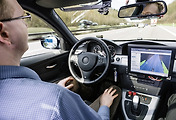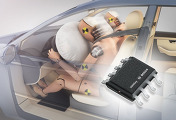Big-block and V8 are not the only engines – American attitudes are changing. The alternatives are modern, downsized engines with gasoline direct injection, diesel engines, and even all-electric powertrains. Just out, “Ward's 10 Best Engines” confirms this trend. This long-standing publication, compiled annually by U.S. automotive journalists, recognizes outstanding powertrain achievement and singles out engines that feature pioneering technology. The list is a litmus test of the way mobility is developing in the United States.
For many years, the ranking was dominated by V6 and V8 engines. But this year, most of the engines singled out by Ward's automotive journalists are no bigger than three liters – and the list even includes a purely electric motor. One other striking feature of the list is that no less than three diesel engines have made it into the top ten. Up to now, diesel has suffered from a negative reputation in the country. The general trend is clear: the U.S. is moving to embrace highly efficient powertrains. “We are seeing a sea-change in the Amercian way of driving. Cars no longer have to be simply big, they have to be very economical as well,” says Dr. Rolf Bulander, member of the Bosch Board of Management. Bosch's Automotive Technology business sector is the beneficiary of this trend – after all, its technology makes this change possible. Bosch technologies are an essential feature of eight out of ten of the Ward's ten Best Engines.
“Electric cars are about the wow factor, not economics”
The first electric motor to make the list – the SMG 180/120 in the Fiat 500e – is made by Bosch itself. As soon as the driver steps on the gas, the compact electric car delivers acceleration of the kind only powerful gasoline engines can equal. The electric Fiat has been praised to the skies by journalists. Its electrical powertrain is clearly in tune with the spirit of the times, as well as with the wishes of many Americans. “Electromobility is not just about emissions and cost, but also about dynamism, torque, and driving enjoyment. In short: electric cars are about the wow factor, not pure economics,” Bulander says. Especially in states such as California, who have introduced legislation to encourage electromobility, electric vehicles are equally about driving enjoyment and ecological sense. However, Bosch regards electrification as the wave of the future in many parts of the world, and is thus driving the development of electrical powertrains forward outside the U.S. as well. The Fiat 500e is one of 30 projects going into production with Bosch technology in 2014.
“The Americans are ready for diesel engines”
The revival of the diesel engine is a sign of a second development in North America. “America has diesel in its sights again. We are confident that the diesel is now ready for the U.S., and Amercans are ready for diesel,” Dr. Rolf Bulander says. Here as well, the automotive journalists singled out three turbo-diesels for the first time. All of them are equipped with modern high-pressure diesel injection systems made by Bosch. But it is not only journalists who are interested in diesels. Car buyers are also taking notice. Even today, where there is a diesel variant available in a model series, 30 percent of car buyers are opting for this efficient powertrain. Just a few years ago, this figure was only ten percent.
There has been a change in public attitudes: for many years, Americans regarded the diesel as a sluggish, noisy industrial engine, unsuitable for accelerating quickly at traffic lights or for leisurely driving. Over the same period in Europe, the diesel developed into a dynamic, economical, and sophisticated powertrain. Now, many Americans have woken up to this trend. More and more, they are coming to appreciate the diesel engine's low consumption and powerful torque. This is why it is no longer just European automakers that are offering diesel-powered vehicles, but U.S. ones as well. Beacon projects include models such as the Chevrolet Cruze, Jeep Cherokee, and Dodge Ram 1500. At present, 37 diesel models are available in the United States. By 2017, this number is set to rise to 60.
“In the U.S. automotive market, gasoline direct injection is where the future lies”
In the U.S., emissions legislation is a significant driver of the change in mindset relating to powertrains. To give an example, a large sedan had to be able to drive at least 28 miles to the gallon in 2012. By 2025, new vehicles will have to have extended this range to nearly 55 miles on average. In European terms, this is equivalent to fuel consumption of roughly 4.3 liters of gasoline per 100 kilometers. And as Americans mainly drive gasoline-powered vehicles – despite the increasing popularity of hybrids, electric cars, and diesels – there will also be a sea-change in the classic American powertrain.
Currently, most of the classic big-block engines in the U.S. are fitted with port fuel injection systems, and consumption is correspondingly high. Pressure from legislators will mean that more efficient combustion processes, such as direct injection, will gain in importance. “In the U.S. automotive market, gasoline direct injection is where the future lies. Drivers are realizing that compact, efficient engines with fewer cylinders can also deliver a lot of power and driving enjoyment,” Bulander says. One example of this new generation of engines is Ford's 1.0 liter EcoBoost engine. There is a clear trend toward powerful, downsized turbo engines fitted with direct injection. Here, displacement is giving way to technology. More efficient combustion means that gasoline direct injection saves fuel while at the same time delivering high torque, and this in every vehicle class. This makes it perfect for U.S. drivers' needs, and is the reason Bosch believes gasoline direct injection can capture a market share of as much as 50 percent in new vehicles.
Automotive Technology is the largest Bosch Group business sector. According to preliminary figures, its 2013 sales came to 30.7 billion euros, or 66 percent of total group sales. This makes the Bosch Group one of the leading automotive suppliers (note: due to a change in the legal rules governing consolidation, the 2013 figures can only be compared to a limited extent with the 2012 figures). Automotive Technology largely operates in the following areas: injection technology for internal-combustion engines, alternative powertrain concepts, efficient and networked powertrain peripherals, systems for active and passive driving safety, assistance and comfort functions, technology for user-friendly infotainment as well as car-to-car and Car2X communication, and concepts, technology, and service for the automotive aftermarket. Bosch has been responsible for important automotive innovations, such as electronic engine management, the ESP® anti-skid system, and common-rail diesel technology.
The Bosch Group is a leading global supplier of technology and services. According to preliminary figures, its roughly 281,000 associates generated sales of 46.4 billion euros in 2013 (Note: due to a change in the legal rules governing consolidation, the 2013 figures can only be compared to a limited extent with the 2012 figures). Its operations are divided into four business sectors: Automotive Technology, Industrial Technology, Consumer Goods, and Energy and Building Technology. The Bosch Group comprises Robert Bosch GmbH and its more than 360 subsidiaries and regional companies in some 50 countries. If its sales and service partners are included, then Bosch is represented in roughly 150 countries. This worldwide development, manufacturing, and sales network is the foundation for further growth. In 2013, Bosch applied for some 5,000 patents worldwide. The Bosch Group’s products and services are designed to fascinate, and to improve the quality of life by providing solutions which are both innovative and beneficial. In this way, the company offers technology worldwide that is “Invented for life.”
Further information is available online at www.bosch.com and www.bosch-press.com, http://twitter.com/BoschPresse.
PI8468 - March 13, 2014
/ Photo & Report provided by Bosch Press Release - sujung.jang@kr.bosch.com
/ MediaPaper.KR mediapaper@ymail.com Sejin Oh
/ The News Article was written by receiving a Press Release.
'Car > BOSCH' 카테고리의 다른 글
| Bosch putting the autopilot on the road (0) | 2014.03.31 |
|---|---|
| 100 years of Bosch starter motors (0) | 2014.03.17 |
| “Realizing economies of scale in how we grow our knowledge base” (0) | 2014.03.13 |
| New Bosch acceleration sensors (0) | 2014.03.11 |
| Bosch is networking vehicles and revolutionizing mobility (0) | 2014.03.05 |






댓글